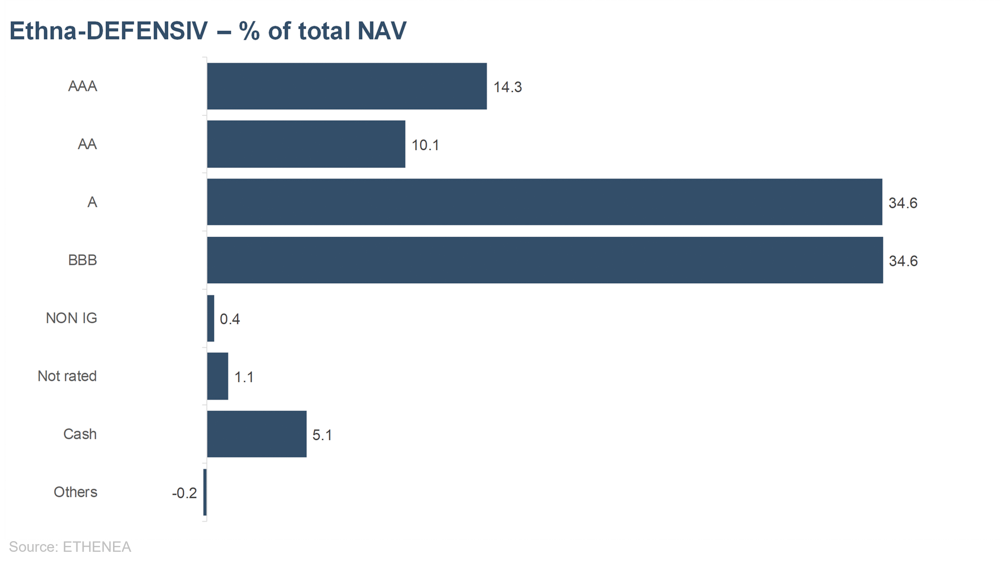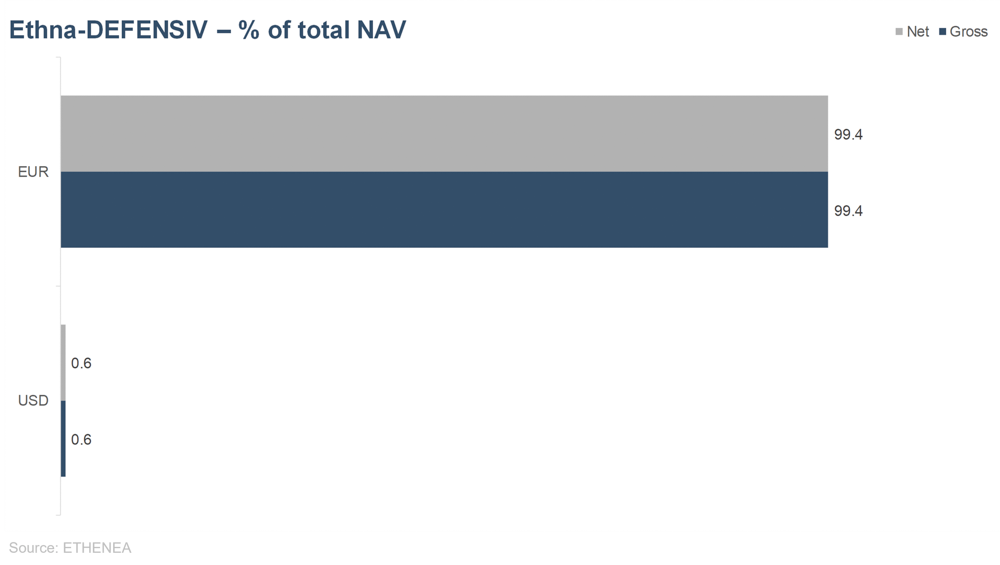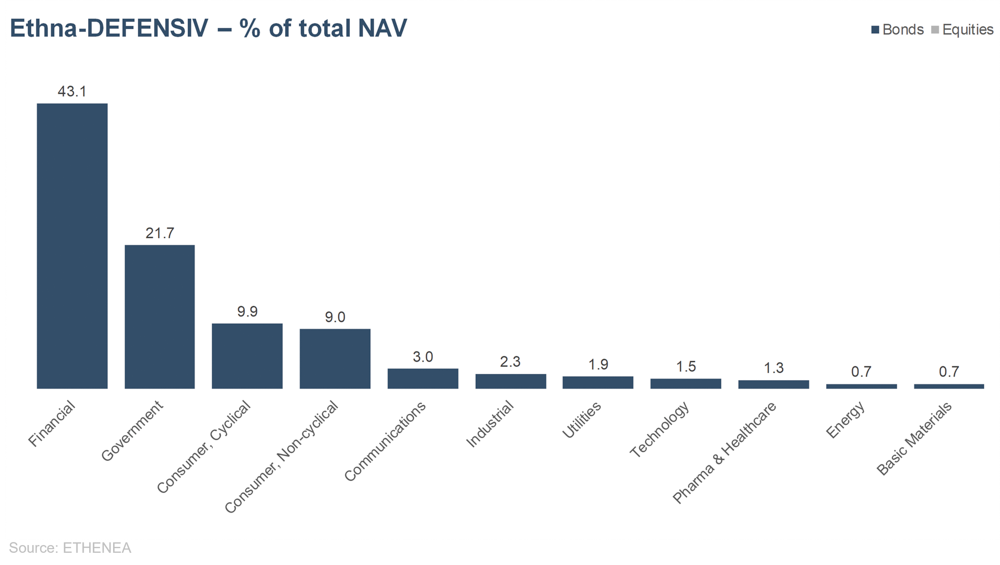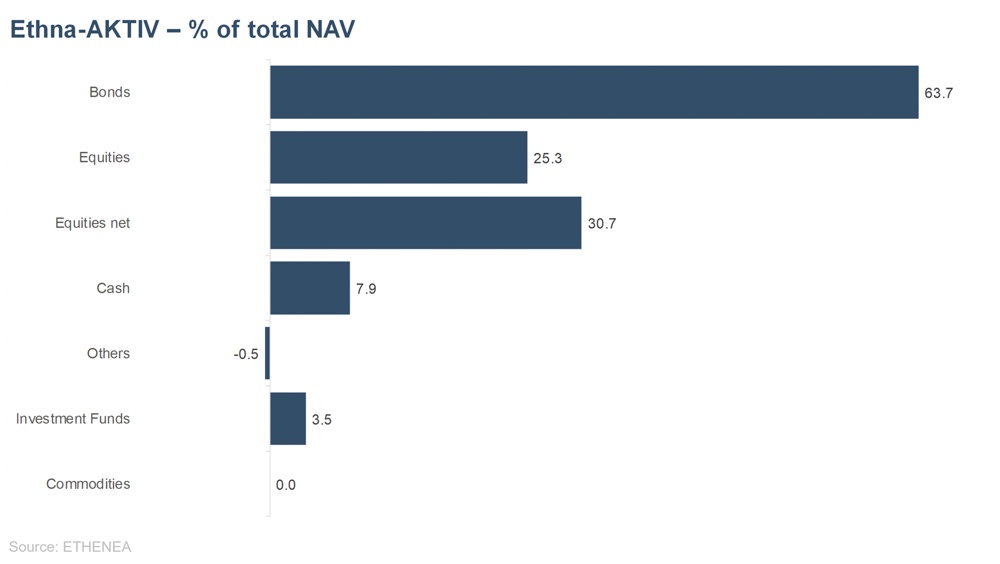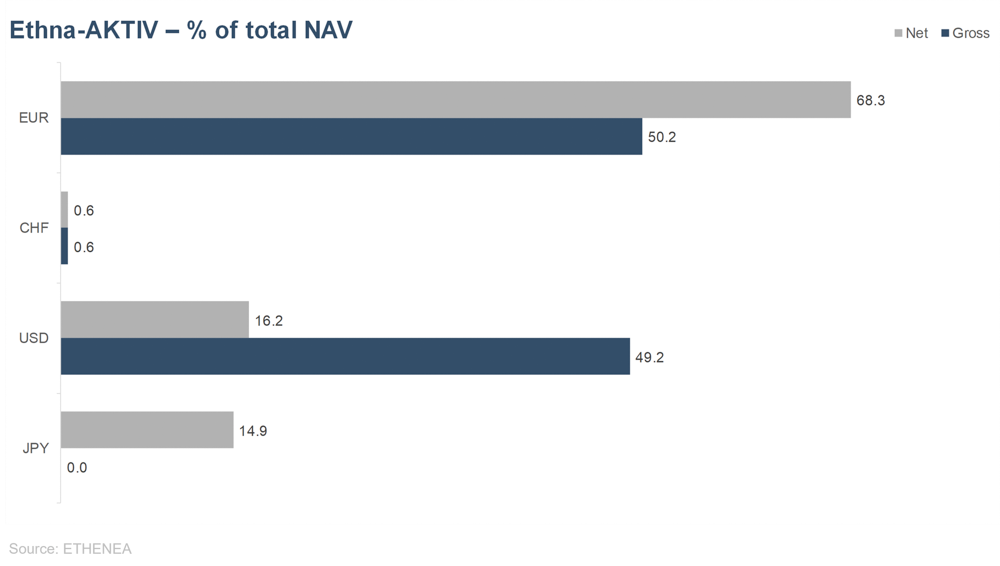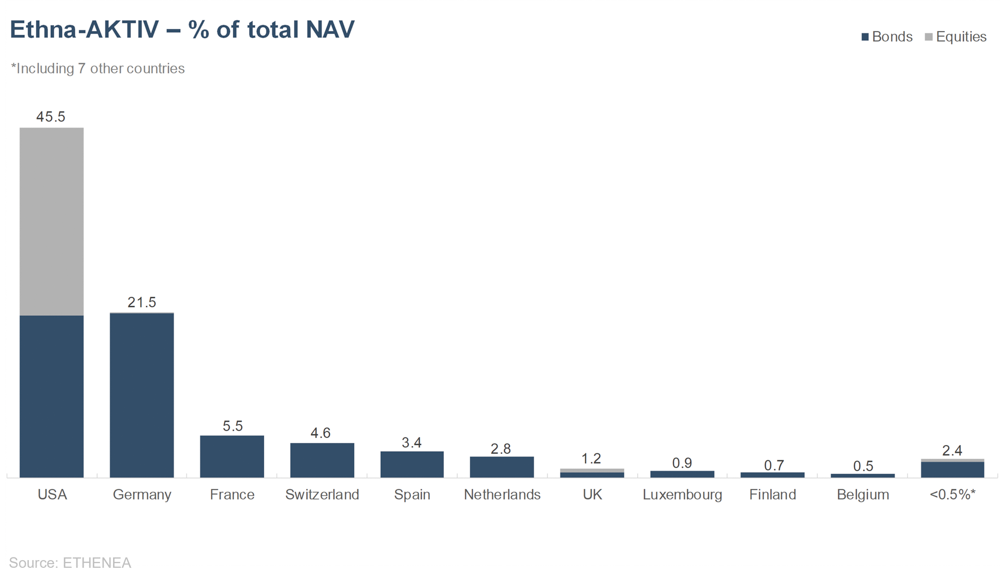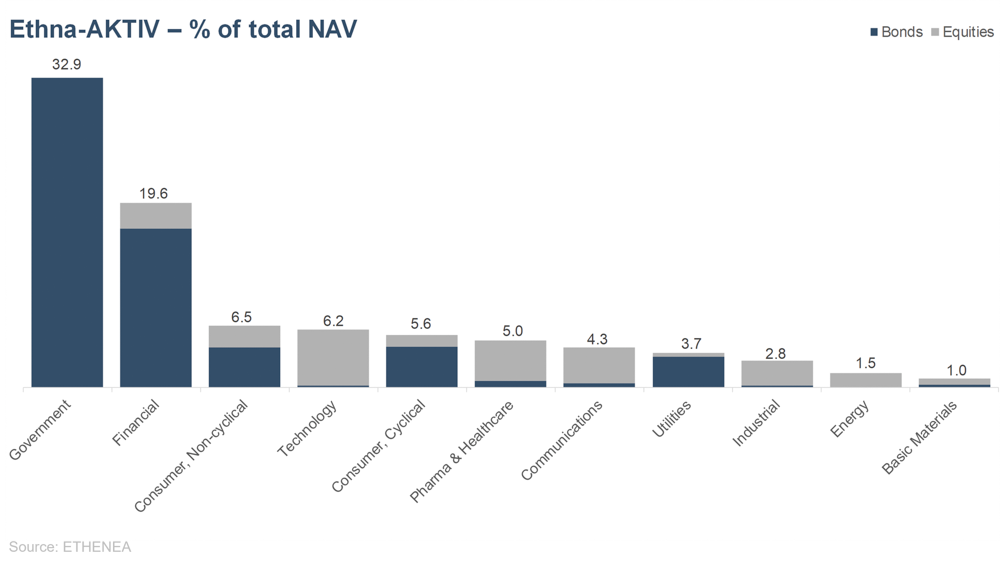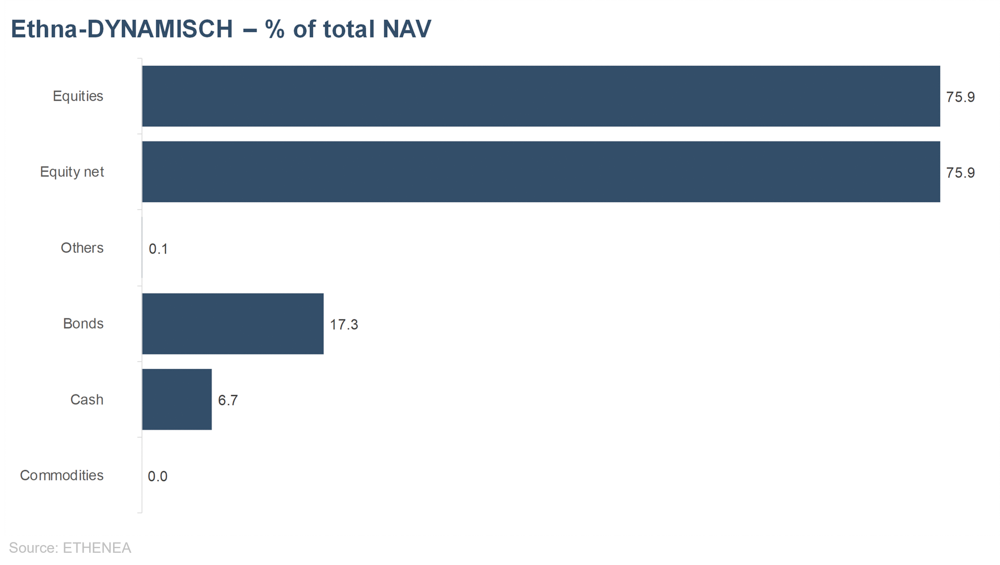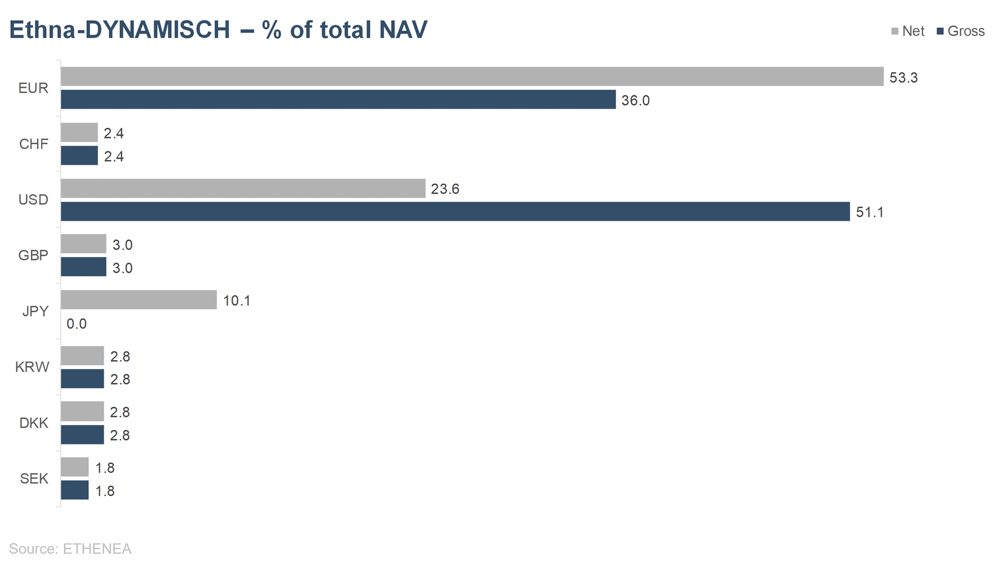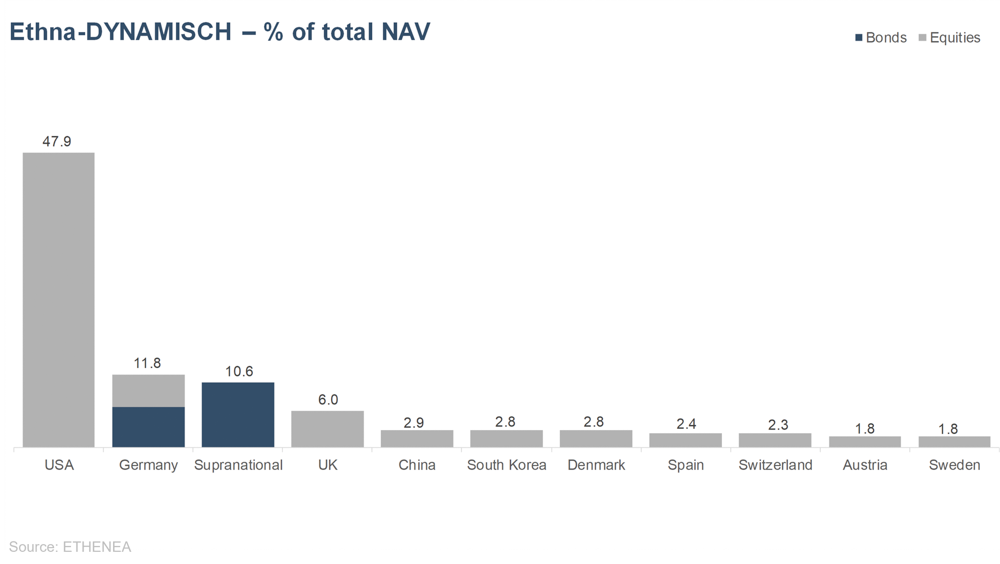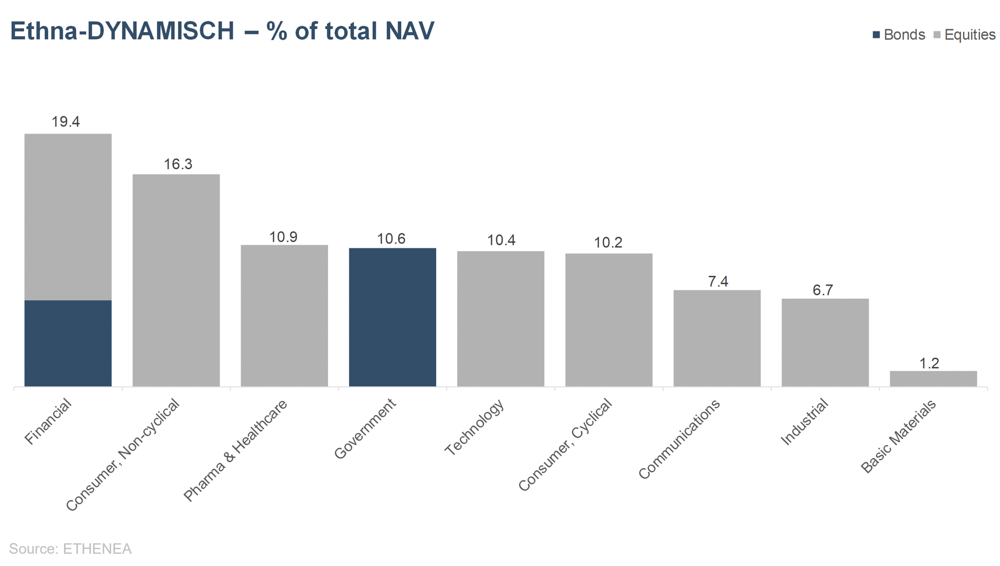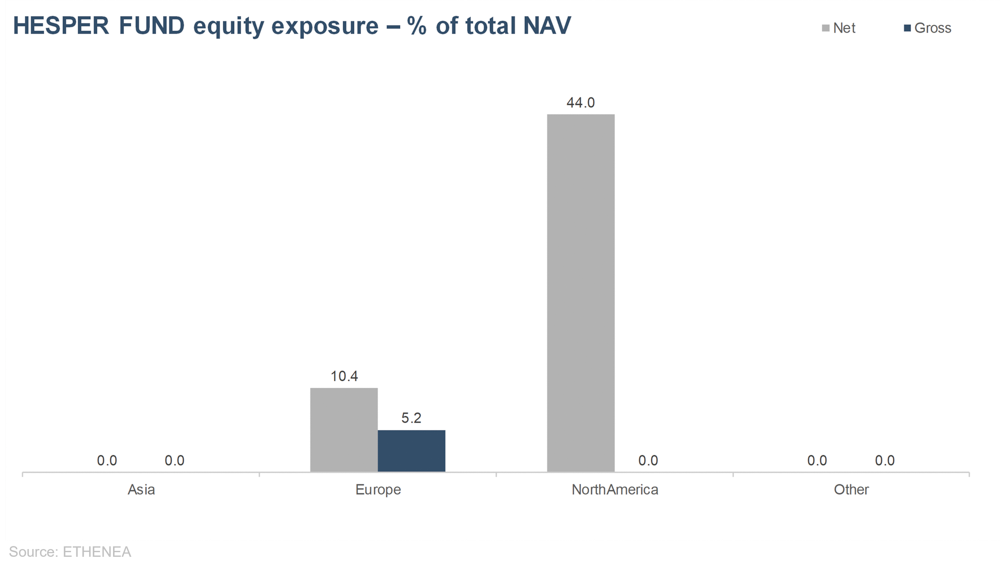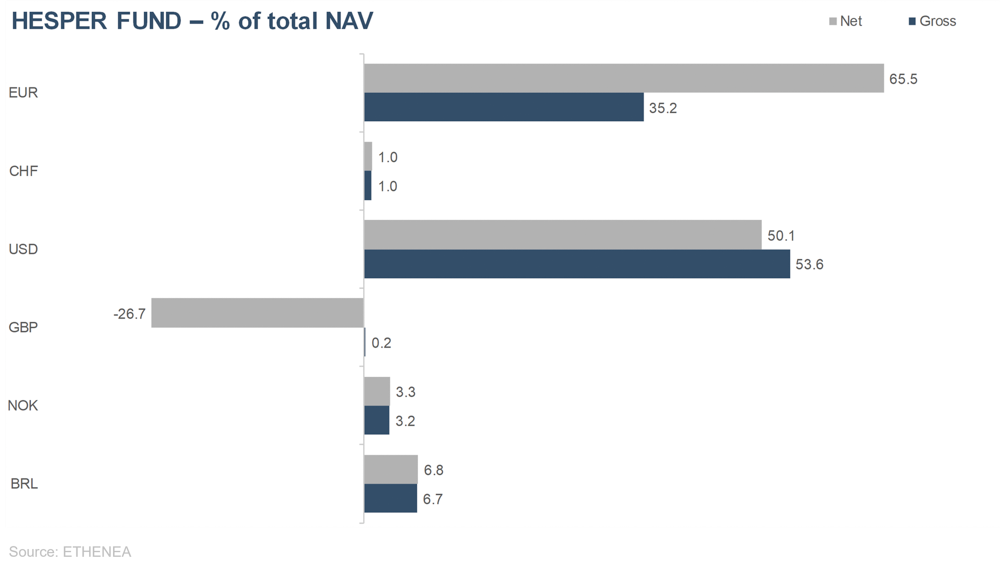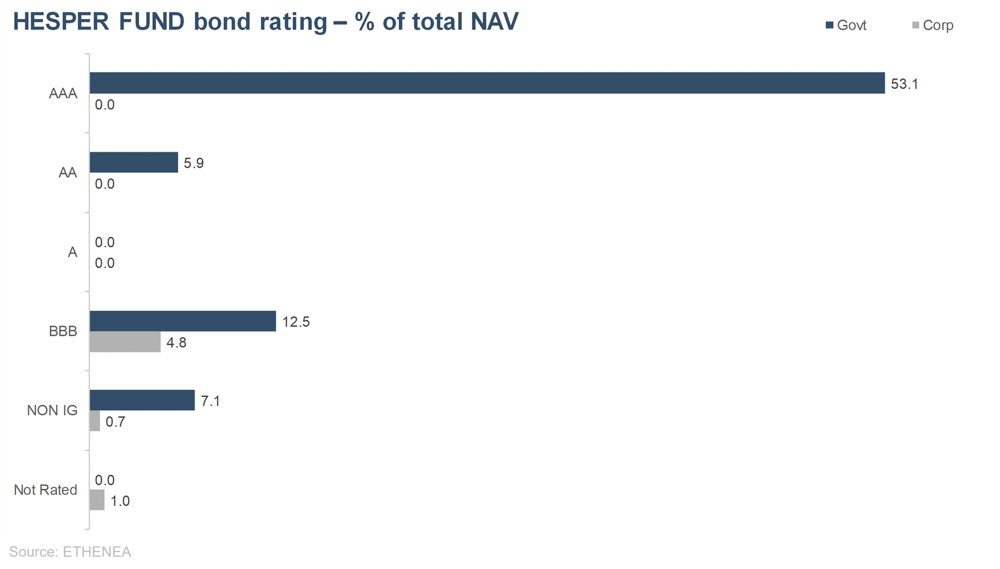

Portfolio Manager Update
Ethna-DEFENSIV
Key points at a glance
- Fed and ECB expected to start cutting interest rates in June 2024
- Normalisation of yield curves not expected until interest rate cuts go ahead
- Positioning: Percentage of floating rate bonds raised to 20%, portfolio continues to hold short positions in futures on 10-year US Treasuries
- Very strong performance in March
31 March 2024 - In March, investors again waited expectantly for decisions from central banks. While the ECB and the Fed did not change key rates, the Swiss SNB pressed ahead and made its first cut, bringing interest rates back down to 1.5%. This was somewhat unexpected, but is not surprising given inflation rates in Switzerland and the SNB predicting average inflation of 1.4% in 2024, 1.2% in 2025 and 1.1% in 2026.
Leading ECB central bankers have held out the prospect of a first rate cut in June 2024. The Fed is also getting close to making its first rate cut. We share the expectation that a rate cut will come in the eurozone and in the U.S. However, we have little confidence that further rate cuts will follow in 2024. In neither economic area has inflation met the critical mark of 2%. Wage pressure remains high on both sides of the Atlantic but is falling. On the one hand, components such as rents and the prices of services are propping up inflation. On the other hand, components such as energy and the prices of goods have been falling for some time now. Overly steep interest rate cuts could give the economy a strong boost, the consequence being that price pressure would be felt by the very components of the market basket that have of late brought inflation down.
What does this mean for the yields of longer-dated sovereign and corporate bonds? The yield curves of German and U.S. sovereign bonds have inverted since November 2022 and July 2022. For investors this means a lower yield for longer residual maturities. This situation is unusual. We expect that this will not be resolved until cuts by the central bank go ahead. Therefore, it may take a bit longer before yield curves fully return to normal, if our prediction that central banks will proceed slowly on interest rate cuts is accurate.
We raised our percentage of floating-rate bonds to 20% in order to maximise interest income. The Ethna-DEFENSIV continues to hold short positions in futures on 10-year U.S. Treasuries, as we expect the slight rises in the yields to continue. Overall, the Ethna-DEFENSIV was able to benefit from the slight falls in EUR yields and the solid interest income in March, and close the month with a very positive performance (T class). The yields on 10-year U.S. Treasuries ended the month virtually unchanged, so our futures position did not detract from performance.
Fund positioning
Ethna-AKTIV
Key points at a glance
- Portfolio remains geared towards an environment of moderate growth, falling but stubborn inflation and a rising stock market trend.
- At 30%, the equity component is in neutral territory, and is exclusively invested in U.S. large caps
- High quality and short maturities continue to characterise the bond portfolio. Modified duration was dialled back down to 0.6.
- We opened an initial 15% position in the Japanese yen.
31 March 2024 - While reviewing the month of March, we noticed that the same themes arose as the previous month. There is no news in relation to the central bank meetings. Nor is there anything on the macro front to change our narrative of moderate growth and persistent inflation. We are in between earnings seasons. For the S&P500, for example, we still expect slightly higher than 10% earnings growth for this year. With margins again at record levels, the expectation for next year is in fact approx. 15%, leading to a risk-on environment on all fronts. Equities are rising, as well as bonds, and gold continues to rise. We are seeing all-time highs everywhere we look, not to mention the soaring cryptomarket on the back of institutional investment. The exuberance of market participants in this regard is the only thing we believe cannot build up much more. This urges us at least to exercise some caution. However, this does not mean that the current rally is about to end abruptly. On the contrary; such trend markets tend to last longer than the bears like. Especially since market breadth is increasing and sentiment works as a better contraindicator in market lows than market highs. However, we shouldn’t chase new highs by maxing out allocations. The Ethna-AKTIV has therefore returned to its neutral equity allocation of 30%, the entirety of which is invested in S&P500 stocks. We continue to stick by our disinvestment of Magnificent Seven stocks, completed in February. We are of the opinion that the winners in the past twelve months will not be the price drivers in the future. The bond portfolio is similarly stability and has changed little. We took advantage of the slight fall in the longer-term U.S. interest rate over the course of the month to reduce portfolio interest-rate sensitivity once again. Modified duration has been reduced from 2 to 0.6 by the overlay. Even though, by making a first rate cut, the Swiss National Bank (SNB) has opened the door for other Western central banks to follow suit, we do not think there will be all that many cuts for the time being and we are confident of further rises at the long end of the yield curve. On the currency front, we kept the USD exposure constant. In addition, we opened an initial 15% position in the Japanese yen mid-month. Both the fact that the yen is now massively undervalued and the Bank of Japan’s (BoJ) active communication that it will intervene and move away from the zero-interest policy and yield curve control are the main tenets of our theory on this. However, a much greater factor in the interest rate differential – which is so key to the currency pairs – is the interest rate moves the ECB makes. Thus, the arguments for a weak yen are getting fewer.
Fund positioning
Ethna-DYNAMISCH
Key points at a glance
- The positive momentum seen in equity markets in recent months continued.
- Looking ahead, our view of the market remains constructive, on the basis of robust fundamentals and fair valuations.
- We are responding to rotations below the surface by making smaller adjustments to individual portfolio weights.
- Our in-depth analysis of Japanese equities culminated in a position in the Japanese yen.
31 March 2024 - The fundamental starting situation has not changed much; on the whole, we still consider it constructive, without too much exuberance. Perhaps it is precisely the absence of this exuberance that in March again contributed to the further steady rise of equity markets. We are also very closely following the valuation of the overall market in these weeks, in addition to the sentiment of market participants. While very attractive opportunities have become increasingly rare as prices have increased, on the whole, equity market valuations remain fair. In our opinion, there are still some excesses to be seen, but these remain very localised and, above all, they are being viewed by the majority of investors for what they are – excesses – and are therefore being avoided. At the same time, economic leading indicators are improving both in the U.S. (e.g. the ISM Manufacturing Index is expanding again for the first time since October 2022) and in Europe (e.g. the expectations surveyed as part of the German ifo Business Climate Index are much better than in previous months). This growing momentum is likely to produce correspondingly positive economic development.
For the portfolio, the environment described means comparatively little movement. We have kept the equity allocation relatively constant around 75%. Similar to the market, there is lots going on at the moment in the form of rotations below the surface, albeit not particularly pronounced either in the market or in the portfolio. First and foremost, we have reduced the size of a number of positions that have done particularly well of late and consequently are no longer as attractive as they were a few months ago. We reinvested the proceeds in other portfolio positions that became more attractive in the meantime. We reduced, for example, the size of the portfolio positions Inditex, ResMed, Salesforce, Visa and Vontier. In particular, we further built up General Mills, Medtronic and Unilever.
We have also been looking more closely at Japan for quite some time now. There is a number of valid reasons to support various investment ideas for the Japanese equity market. In analysing potential equity investments in Japan, however, we mostly came to the conclusion that the predominant factor affecting Japanese equities is the currency, which has been very weak to date. Consequently, we have been reluctant to open positions in Japanese equities. Meanwhile, the currency itself inevitably attracted our attention. The weakness in the Japanese yen (JPY) has so far been moving in step with the yield and interest rate differential between it and the USD or EUR, but has recently started widening to a disproportionate extent. Since the BoJ raised interest rates in March for the first time in 17 years while the Fed and ECB stuck to the prospect of interest rate cuts in summer, and the JPY also faced record-high short positions, we saw a very attractive opportunity to take a position in the yen. This was executed by way of currency derivatives on a scale of around 10% of the fund at prices just shy of 165 in the EUR-JPY currency pair. Against this backdrop, we see enormous upside potential for the yen in the short- to medium-term, while the risks should be limited by potential currency intervention by Japan.
On the whole, we thus consider the Ethna-DYNAMISCH still to be well equipped to take advantage of market opportunities accordingly.
Fund positioning
* “Cash” comprises term deposits, call money and current accounts/other accounts. “Equities net” comprises direct investments and exposure resulting from equity derivatives.
HESPER FUND – Global Solutions (*)
The most important at a glance
Major central banks hint at rate cuts
- Central banks are getting eager to cut interest rates, but the timing and depth remain uncertain.
- Global yields drifted without a clear trend as rate cut expectations moderated further.
- Global equities extended their rally, with the S&P hitting new records with better breadth on a soft-landing outlook and despite the Fed’s adjustment to more realistic rate cut expectations.
- After 17 years, the Bank of Japan ended the era of negative rates.
- Geopolitical tensions rose as a deadly terrorist attack in Moscow left the Russian government suspicious of Western involvement. The Security Council approved a long-awaited resolution on Gaza, calling for an immediate ceasefire, and the unconditional release of all hostages.
- Chinese equities struggled to follow the global rally.
- The HESPER FUND – Global Solutions fine-tuned its portfolio allocation. Net equity exposure was kept above 50% and duration close to neutral most of the time. In FX, the fund sharply reduced the long exposure to the Norwegian krone to 3%, kept the US dollar at around 50%, took profit on the Swiss franc short exposure of -17% and cut GBP short exposure to -27%.
31.03.24 - A lot of action and clues from central banks in March
A soft landing or even a “no landing” scenario seems more realistic than the gloomy fears of a US recession. The tightening cycle did not kill the US economic expansion last year. The path of rate cuts in the US is still uncertain, but the direction is clear, and the Fed will start reversing policy in 2024. With no recession in sight, we expect the still inverted yield curve to return to a normal slope in the future.
Central banks in the advanced western economies are becoming keener to cut rates as early as June. Market expectations of deep and rapid rate cuts have been progressively adjusting to a more realistic path but are still somewhat optimistic. The Swiss National Bank (SNB) started the rate-cutting season, surprising the market with a 0.25% cut and raising expectations that other European central banks will soon follow suit. Japan, on the other hand, ended an era of negative interest rates but left few hints as to further hikes. Surprisingly, the yen dropped on the Bank of Japan’s (BoJ) dovish tone and global yields were not dragged up as feared. As the yen slid to its weakest level since 1990, the BoJ stepped up its intervention warnings.
It will be the year of the Fed’s pivot to a less restrictive policy, but it is also the year of global elections. Domestic politics will influence policy and markets, with more than over 70 countries holding elections in 2024. In the US, the Biden vs. Trump rematch is likely to result in continued fiscal stimulus and more protectionist policies, which will likely support growth but also make the disinflation path more uncertain. Volatility is also something we should keep in mind as we approach election day in November.
A soft landing scenario for the US economy has pushed global equities higher
US equities extended a five-month rally, with most indices hitting new hights. the prospect of a soft landing has become the key driver of higher share prices. The US equity market has adjusted to the Fed’s wait-and-see approach and has hit a series of all-time hights despite multiple delays in the expected timing of rate cuts
In the US, the major indices hit new record highs as the equity rally broadened, favouring laggard sectors. The S&P 500 gained 3.1%, the DJIA increased by 2.1%, the tech-heavy NASDAQ rose 1.8% and the small cap index Russel 2000 jumped 3.4%.
In Europe, the Euro Stoxx Index surged 4.2% (+4.2% in USD), while the FTSE 100 rose 4.2% (+4.3% in USD) on hopes of interest rate cuts. The Swiss Market Index gained 2.5% (0.6% in USD as the Swiss franc weakened further).
In Asia, China’s efforts to stabilise its financial markets stalled in March. The Hang Seng barely rose by 0.2% and the CSI 300 gained 0.6% (+0.2% in USD). The Korean stock market jumped 3.9% (+3% in USD) and the Indian Sensex gained 1.6% (+1% in USD). The Japanese stock market weathered a historic change in monetary policy as the Nikkei jumped 3.1% (+1.5% in USD).
HESPER FUND – Macro Scenario: be ready for slow-motion rate cuts
Central banks are navigating a challenging scenario of uncertain disinflation, slowing economic activity amid political elections, and rising geopolitical tensions. Central banks need to carefully assess the risks of remaining hawkish for too long, with the risk of cutting rates too soon and missing their target. In the US, recent inflation readings have been disappointing, but the Fed is sticking to its story of a disinflationary path. However, the disinflation process may be slower and bumpier than is priced in by the markets. As long as the economy holds up, long-term yields remain well behaved and the carrot-on-a-stick of multiple rate cuts remains in sight, equity markets should however continue to perform decently.
With the supply side of the inflation equation already delivering its benefits, we may still need to see some softening in demand to achieve the central banks’ inflation targets. The combination of a strong fiscal support, a healthy labour market, solid consumer confidence and geopolitical tensions could still delay or even spoil the disinflationary path.
Positionierung und Monatsperformance
The HESPER FUND – Global Solutions increased in March (unit class T-6 EUR +1.52%), supported by equities, a slightly negative duration exposure and FX bets. YTD, the fund is up 3.56%.
The HESPER FUND maintained an overall equity exposure of over 50%. Duration exposure was kept neutral to slightly negative most of the time. The fund continued to trade actively in the FX space, maintaining the US dollar exposure at 50%. GBP short exposure was reduced to -27% as we dismantled long NOK bets. We took profits on several trades against the CHF, which we might re-open if the Swiss franc recoups some strength
The breakdown of MTD (+1.52%) was +0.20% fixed income (+0.49% long positions, -0.29% short future positions), +1.32% equities, +0% commodities, +0.10% currencies and -0.10% fees and expenses. Equities, hedging duration and the depreciation of the Swiss franc contributed to performance. Decorrelation with traditional assets such as equities and bonds remained high.
Total assets fell to EUR 58.6 million at the end of the month. The unit class T-6 EUR unit class was 7.18% below its all-time high on 29 September 2022.
Volatility over the last 250 days rose up to 6%, maintaining an attractive risk/return profile. The annualised return since inception has risen to 3.56%.
Looking ahead to next month, the fund has continued to stay far from its reference currency and to trade actively in the FX space. Currently, the currency exposure of the HESPER FUND – Global Solutions is as follows: USD 50%, BRL 6.7%, CHF 1% and GBP -27%.
As in the past, we will continue to monitor and calibrate the fund’s exposure to the various and different asset classes in line with market sentiment and changes in the macroeconomic baseline scenario.
*HESPER FUND - Global Solutions is currently only authorised for distribution in Germany, Luxembourg, Belgium, Italy, France, Austria and Switzerland.
Fund positioning
The content of this page is intended for professional investors only.
Please contact us at any time if you have questions or suggestions.
ETHENEA Independent Investors S.A.
16, rue Gabriel Lippmann · 5365 Munsbach
Phone +352 276 921-0 · Fax +352 276 921-1099
info@ethenea.com · ethenea.com
This is a marketing communication. It is for product information purposes only and is not a mandatory statutory or regulatory document. The information contained in this document does not constitute a solicitation, offer or recommendation to buy or sell units in the fund or to engage in any other transaction. It is intended solely to provide the reader with an understanding of the key features of the fund, such as the investment process, and is not deemed, either in whole or in part, to be an investment recommendation. The information provided is not a substitute for the reader's own deliberations or for any other legal, tax or financial information and advice. Neither the investment company nor its employees or Directors can be held liable for losses incurred directly or indirectly through the use of the contents of this document or in any other connection with this document. The currently valid sales documents in German (sales prospectus, key information documents (PRIIPs-KIDs) and, in addition, the semi-annual and annual reports), which provide detailed information about the purchase of units in the fund and the associated opportunities and risks, form the sole legal basis for the purchase of units. The aforementioned sales documents in German (as well as in unofficial translations in other languages) can be found at www.ethenea.com and are available free of charge from the investment company ETHENEA Independent Investors S.A. and the custodian bank, as well as from the respective national paying or information agents and from the representative in Switzerland. The paying or information agents for the funds Ethna-AKTIV, Ethna-DEFENSIV and Ethna-DYNAMISCH are the following: Austria, Belgium, Germany, Liechtenstein, Luxembourg: DZ PRIVATBANK S.A., 4, rue Thomas Edison, L-1445 Strassen, Luxembourg; France: CACEIS Bank France, 1-3 place Valhubert, F-75013 Paris; Italy: State Street Bank International – Succursale Italia, Via Ferrante Aporti, 10, IT-20125 Milano; Société Génerale Securities Services, Via Benigno Crespi, 19/A - MAC 2, IT-20123 Milano; Banca Sella Holding S.p.A., Piazza Gaudenzio Sella 1, IT-13900 Biella; Allfunds Bank S.A.U – Succursale di Milano, Via Bocchetto 6, IT-20123 Milano; Spain: ALLFUNDS BANK, S.A., C/ Estafeta, 6 (la Moraleja), Edificio 3 – Complejo Plaza de la Fuente, ES-28109 Alcobendas (Madrid); Switzerland: Representative: IPConcept (Schweiz) AG, Münsterhof 12, Postfach, CH-8022 Zürich; Paying Agent: DZ PRIVATBANK (Schweiz) AG, Münsterhof 12, CH-8022 Zürich. The paying or information agents for HESPER FUND, SICAV - Global Solutions are the following: Austria, Belgium, France, Germany, Luxembourg: DZ PRIVATBANK S.A., 4, rue Thomas Edison, L-1445 Strassen, Luxembourg; Italy: Allfunds Bank S.A.U – Succursale di Milano, Via Bocchetto 6, IT-20123 Milano; Switzerland: Representative: IPConcept (Schweiz) AG, Münsterhof 12, Postfach, CH-8022 Zürich; Paying Agent: DZ PRIVATBANK (Schweiz) AG, Münsterhof 12, CH-8022 Zürich. The investment company may terminate existing distribution agreements with third parties or withdraw distribution licences for strategic or statutory reasons, subject to compliance with any deadlines. Investors can obtain information about their rights from the website www.ethenea.com and from the sales prospectus. The information is available in both German and English, as well as in other languages in individual cases. Producer: ETHENEA Independent Investors S.A.. Distribution of this document to persons domiciled in countries in which the fund is not authorised for distribution, or in which authorisation for distribution is required, is prohibited. Units may only be offered to persons in such countries if this offer is in accordance with the applicable legal provisions and it is ensured that the distribution and publication of this document, as well as an offer or sale of units, is not subject to any restrictions in the respective jurisdiction. In particular, the fund is not offered in the United States of America or to US persons (within the meaning of Rule 902 of Regulation S of the U.S. Securities Act of 1933, in its current version) or persons acting on their behalf, on their account or for the benefit of a US person. Past performance should not be taken as an indication or guarantee of future performance. Fluctuations in the value of the underlying financial instruments or their returns, as well as changes in interest rates and currency exchange rates, mean that the value of units in a fund, as well as the returns derived from them, may fall as well as rise and are not guaranteed. The valuations contained herein are based on a number of factors, including, but not limited to, current prices, estimates of the value of the underlying assets and market liquidity, as well as other assumptions and publicly available information. In principle, prices, values, and returns can both rise and fall, up to and including the total loss of the capital invested, and assumptions and information are subject to change without prior notice. The value of the invested capital or the price of fund units, as well as the resulting returns and distribution amounts, are subject to fluctuations or may cease altogether. Positive performance in the past is therefore no guarantee of positive performance in the future. In particular, the preservation of the invested capital cannot be guaranteed; there is therefore no warranty given that the value of the invested capital or the fund units held will correspond to the originally invested capital in the event of a sale or redemption. Investments in foreign currencies are subject to additional exchange rate fluctuations or currency risks, i.e. the performance of such investments also depends on the volatility of the foreign currency, which may have a negative impact on the value of the invested capital. Holdings and allocations are subject to change. The management and custodian fees, as well as all other costs charged to the fund in accordance with the contractual provisions, are included in the calculation. The performance calculation is based on the BVI (German federal association for investment and asset management) method, i.e. an issuing charge, transaction costs (such as order fees and brokerage fees), as well as custodian and other management fees are not included in the calculation. The investment performance would be lower if the issuing surcharge were taken into account. No guarantee can be given that the market forecasts will be achieved. Any discussion of risks in this publication should not be considered a disclosure of all risks or a conclusive handling of the risks mentioned. Explicit reference is made to the detailed risk descriptions in the sales prospectus. No guarantee can be given that the information is correct, complete or up to date. The content and information are subject to copyright protection. No guarantee can be given that the document complies with all statutory or regulatory requirements which countries other than Luxembourg have defined for it. Note: The most important technical terms can be found in the glossary at www.ethenea.com/glossary. Information for investors in Belgium: The prospectus, the key information documents (PRIIPs-KIDs), the annual reports and the semi-annual reports of the sub-fund are available in French free of charge upon request from the investment company ETHENEA Independent Investors S.A., 16, rue Gabriel Lippmann, 5365 Munsbach, Luxembourg and from the representative: DZ PRIVATBANK S.A., 4, rue Thomas Edison, L-1445 Strassen, Luxembourg. Information for investors in Switzerland: The country of origin of the collective investment scheme is Luxembourg. The representative in Switzerland is IPConcept (Schweiz) AG, Münsterhof 12, P.O. Box, CH-8022 Zurich. The paying agent in Switzerland is DZ PRIVATBANK (Schweiz) AG, Münsterhof 12, CH-8022 Zurich. The prospectus, the key information documents (PRIIPs-KIDs), and the Articles of Association, as well as the annual and semi-annual reports, can be obtained free of charge from the representative. Copyright © ETHENEA Independent Investors S.A. (2024) All rights reserved. 08/06/2021


